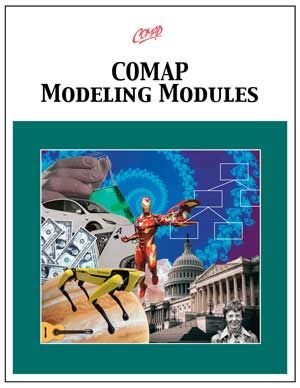
COMAP’s Mathematical Modeling Modules
COMAP presents a series of modules designed for teaching mathematics through the modeling of real-world phenomena. Most modules are suitable for use in high school classes, and some can be used in middle school, undergraduate courses, and in teacher education.
These modules are free to download and use in classrooms. Teachers have our permission to copy and distribute the student pages in their classes.
Each module in the series is built around several classroom activities. Each module includes student activity pages, teaching notes, and answers. Teaching notes and answers are in two-column format at the beginning of the module. Student activity pages are in full-page format at the end of the module.
Since technology plays a key role in mathematical modeling, most modules in this series offer opportunities to apply one or more forms of technology, such as graphing calculators and/or online graphing utilities, spreadsheets, and geometric utilities.
We have grouped the modules by primary math topic and included a brief description of each module to aid teachers in module selection. However, be aware that a realistic modeling scenario often involves application of several diverse mathematical concepts.
Since each module includes teaching notes and answers, these modules are available only to teachers. We ask that you first submit a short form to help us identify you as a teacher. We do not share your information with anyone. Shortly after submitting your form, you will receive an email with login information. After your initial login, please check back occasionally—new modules will be posted several times per year.
To further enrich your students' modeling experiences, please consider participating in one of our modeling competitions: MCM, ICM, HiMCM/MidMCM, or IM2C.
Pre-Algebra Modules
Voting Models
HiMCM Problem: Storing the Sun
This module is based on a problem from the 2021 High School Mathematical Contest in Modeling (HiMCM). The problem involves finding a configuration for an energy storage system to support solar panels that power an off-grid house. Mathematical tools include proportional reasoning and unit analysis.
Algebra Modules
Modeling Botpaths with Linear Functions
Modeling Pooled-Sample Testing, Part I
Modeling the Kemp’s Ridley Sea Turtle Population
Discrete Mathematics
Modeling Airline Scheduling
Network science is an interdisciplinary field that combines elements of graph theory with computer and data science to better understand the connections and relationships that are all around us. This module uses graph theory to model and study some of the complexity of airline scheduling that arises from considering plane availability, optimal routes, crew compositions, and customer satisfaction.
Geometry Modules
Scene From Above: Modeling Environmental Changes
The context for this Modeling Module is studying changes to the environment by using map and satellite images to estimate areas of irregularly shaped regions. One particular focus is the spread of wildfires in California in 2025.
Proximity: Modeling Rainfall
The context for this Modeling Module is estimating the amount of rainfall in a certain region based on rain gauges spread across the region. It features coordinate geometry and makes use of weighted averages with the weights coming from areas of polygons defined by perpendicular bisectors.
Modeling Packaging
Statistics & Probability Modules
Could These Bones Be Amelia Earhart’s?
The modeling in this module involves using statistical techniques to predict human height from bone lengths. Mathematical tools include unit conversion, slopes of lines, equations of lines from two points, fitting a line to data (least squares), and coefficient of correlation (r2).
Modeling Pooled-Sample Testing, Part II
Trigonometry Modules
Modeling Daylight in the Northern Hemisphere
If you use our modules in your classes, we invite you to gives us feedback on the site to tell us about your experience. You can also email us to identify errors, but please be as specific as possible when doing so (i.e., page number, question number).
For questions and comments please contact us here or email